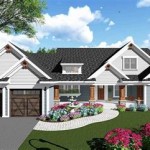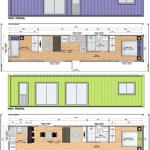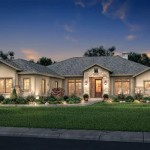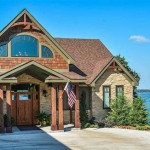Bungalow Style House Plans encompass a unique architectural style that evokes a sense of simplicity, comfort, and functionality. These plans typically feature one story, a low-pitched roof with wide eaves, and an open floor plan that seamlessly blends indoor and outdoor living spaces. An excellent example of a bungalow-style house is the iconic Gamble House in Pasadena, California, designed by the renowned architects Greene and Greene. The Gamble House epitomizes the bungalow style, showcasing its characteristic low-slung profile, overhanging roof, and rustic charm.
In the following sections, we will delve deeper into the distinctive features of Bungalow Style House Plans, exploring their historical roots, design principles, and various types. We will also provide useful tips and resources for homeowners considering building a bungalow-style home, ensuring a comfortable and aesthetically pleasing living environment.
Bungalow Style House Plans offer a range of notable features that contribute to their enduring popularity.
- Single story layout
- Low-pitched roof with wide eaves
- Open floor plan
- Front porch or veranda
- Natural materials (wood, stone, brick)
- Built-in cabinetry and window seats
- Arts and Crafts influences
- Functional and comfortable
- Energy-efficient
- Affordable to build
These characteristics combine to create charming and livable homes that have stood the test of time.
Single story layout
Bungalow Style House Plans are characterized by their single story layout, which offers several advantages. Firstly, it eliminates the need for stairs, making the home more accessible for individuals with mobility issues or young children. Secondly, a single story layout promotes a more efficient use of space, as there is no wasted area dedicated to hallways or staircases. This allows for a more open and expansive living environment.
Single story bungalows also tend to have a lower profile than multi-story homes, which can be beneficial in areas with strict height restrictions or scenic views. Additionally, a single story layout simplifies construction and maintenance, potentially reducing costs and making the home more energy-efficient. Overall, the single story layout of Bungalow Style House Plans contributes to their functionality, comfort, and affordability.
Furthermore, a single story layout fosters a stronger connection between the indoor and outdoor spaces. With easy access to the outdoors from multiple rooms, homeowners can seamlessly extend their living areas into their gardens or patios, creating a more integrated and enjoyable living environment.
In summary, the single story layout of Bungalow Style House Plans offers numerous benefits, including accessibility, efficient space utilization, a lower profile, simplified construction and maintenance, and a stronger connection to the outdoors.
Low-pitched roof with wide eaves
Bungalow Style House Plans are renowned for their low-pitched roofs with wide eaves, which play a significant role in defining the overall character and functionality of the home.
The low pitch of the roof, typically between 10 and 25 degrees, gives the bungalow its characteristic horizontal emphasis and visually anchors it to the ground. This low profile also reduces the overall height of the home, making it more suitable for narrow lots or areas with height restrictions. Additionally, a low-pitched roof minimizes the amount of attic space, reducing construction costs and energy loss.
The wide eaves, which extend beyond the walls of the home, provide several practical benefits. They offer protection from the elements, shielding the walls and windows from rain, snow, and excessive sunlight. The eaves also create shaded outdoor areas, allowing homeowners to enjoy their patios or verandas even during hot weather. Furthermore, wide eaves enhance the aesthetic appeal of the bungalow, adding a touch of rustic charm and visual interest.
The combination of a low-pitched roof and wide eaves is not only aesthetically pleasing but also contributes to the energy efficiency of Bungalow Style House Plans. The low roof profile reduces heat gain in the summer, while the wide eaves provide shade and minimize heat loss in the winter. This combination helps regulate indoor temperatures, reducing the need for excessive heating or cooling.
In summary, the low-pitched roof with wide eaves is an integral part of Bungalow Style House Plans, offering a range of functional and aesthetic benefits. It provides protection from the elements, creates shaded outdoor areas, enhances curb appeal, and contributes to the energy efficiency of the home.
Open floor plan
Bungalow Style House Plans often incorporate an open floor plan, which is characterized by a seamless flow of space between the living room, dining room, and kitchen areas. This design approach creates a more spacious and inviting living environment, while also promoting a sense of togetherness and community.
- Eliminates visual barriers:
An open floor plan removes traditional walls and partitions, allowing for a more open and expansive feel. This uninterrupted sightline enhances the sense of space and makes the home feel larger than it actually is.
- Promotes family interaction:
With an open floor plan, family members can easily interact and engage with each other, even while performing different activities. This fosters a sense of community and togetherness, making it an ideal layout for families who spend a lot of time together.
- Provides flexibility and adaptability:
An open floor plan offers greater flexibility in furniture placement and room arrangement. Homeowners can easily adapt the space to their changing needs and preferences, whether it’s creating a more open living area for entertaining or dividing the space into more defined zones for privacy.
- Enhances natural light and ventilation:
The absence of walls and partitions allows for better natural light penetration, creating a brighter and more welcoming atmosphere. Additionally, an open floor plan facilitates cross-ventilation, promoting air circulation and reducing the need for artificial lighting and cooling systems.
Overall, the open floor plan is a defining feature of Bungalow Style House Plans, contributing to their spaciousness, functionality, and overall livability. It creates a more cohesive and inviting living environment that encourages family interaction, flexibility, and a connection to the outdoors.
Front porch or veranda
Bungalow Style House Plans often feature a welcoming front porch or veranda, which serves as a charming and functional extension of the living space.
- Extends the living space outdoors:
A front porch or veranda provides an additional outdoor living area where homeowners can relax, entertain guests, or simply enjoy the fresh air and scenery. It seamlessly extends the living space beyond the confines of the house, creating a more connected and inviting environment.
- Enhances curb appeal:
A well-designed front porch or veranda adds significant curb appeal to a Bungalow Style House. It creates a warm and inviting first impression, showcasing the home’s character and charm. A welcoming porch or veranda can also increase the home’s overall value.
- Provides shelter from the elements:
The roof of a front porch or veranda provides shelter from rain, snow, and excessive sunlight. This allows homeowners to enjoy their outdoor space in any weather condition, whether it’s a sunny afternoon or a rainy evening.
- Promotes social interaction:
A front porch or veranda is an ideal place for social interaction. It provides a casual and comfortable setting for neighbors to gather, chat, and build relationships. This fosters a sense of community and makes the neighborhood a more friendly and welcoming place.
Overall, the front porch or veranda is an essential element of Bungalow Style House Plans, contributing to their functionality, curb appeal, and overall livability. It creates a seamless connection between the indoor and outdoor spaces, providing homeowners with a versatile and enjoyable living environment.
Natural materials (wood, stone, brick)
Bungalow Style House Plans often incorporate natural materials such as wood, stone, and brick, which contribute significantly to their aesthetic appeal, durability, and overall character.
- Wood:
Wood is a classic material used in Bungalow Style House Plans, both for its structural and aesthetic qualities. It provides a warm and inviting feel, adding a touch of rustic charm to the home. Wood is commonly used for siding, roofing, window frames, and interior paneling, creating a cohesive and natural look.
- Stone:
Stone is another popular material used in Bungalow Style House Plans, particularly for foundations, chimneys, and exterior accents. It adds a sense of solidity and permanence to the home, while also providing excellent insulation and protection from the elements. Stone can range in color and texture, allowing homeowners to customize the look of their home and blend it seamlessly with the surrounding environment.
- Brick:
Brick is a durable and versatile material that is often used in Bungalow Style House Plans. Its classic red color and textured surface add a touch of sophistication and charm to the home. Brick is commonly used for exterior walls, chimneys, and walkways, providing both aesthetic appeal and structural integrity. Additionally, brick is fire-resistant and requires minimal maintenance, making it a practical choice for homeowners.
- Combination of materials:
Many Bungalow Style House Plans combine different natural materials to create a unique and visually interesting look. For example, a home may feature a stone foundation, wood siding, and a brick chimney. This combination of materials adds depth and character to the home, while also highlighting its craftsmanship and attention to detail.
Overall, the use of natural materials in Bungalow Style House Plans emphasizes their connection to nature and their timeless appeal. These materials not only enhance the aesthetic beauty of the home but also contribute to its durability, energy efficiency, and overall livability.
Built-in cabinetry and window seats
Built-in cabinetry and window seats are defining features of Bungalow Style House Plans, adding both functionality and charm to the home. These elements are seamlessly integrated into the design, providing practical storage solutions and cozy nooks that enhance the overall livability and aesthetic appeal of the home.
Built-in cabinetry
Bungalow Style House Plans often incorporate built-in cabinetry throughout the home, maximizing space utilization and creating a cohesive and organized living environment. These cabinets are typically custom-designed to fit specific areas, such as under windowsills, along hallways, or in corners. Built-in cabinetry provides ample storage for books, dishes, linens, and other household items, reducing clutter and maintaining a tidy and functional space.
In the kitchen, built-in cabinetry is often used to create efficient and ergonomic workspaces. Wall-mounted cabinets provide ample storage for dishes, cookware, and pantry items, while base cabinets offer convenient access to pots, pans, and appliances. Built-in cabinetry can also be used to create kitchen islands or breakfast nooks, maximizing space and creating a more inviting and functional cooking and dining area.
Window seats
Window seats are another characteristic feature of Bungalow Style House Plans. These cozy nooks are typically built into bay windows or other areas with ample natural light, creating a comfortable and inviting spot for reading, relaxation, or simply enjoying the view. Window seats often feature built-in storage underneath, providing additional space for books, blankets, or other items.
Window seats add a touch of charm and character to any room. They can be used to create a cozy reading nook in the living room, a peaceful retreat in the bedroom, or a sunny spot for morning coffee in the kitchen. Window seats not only enhance the functionality of the home but also contribute to its overall aesthetic appeal, creating a warm and inviting atmosphere.
Overall, built-in cabinetry and window seats are essential elements of Bungalow Style House Plans, combining functionality and charm to create a comfortable and livable home. These elements maximize space utilization, provide ample storage, and create cozy and inviting nooks that enhance the overall aesthetic appeal of the home.
Arts and Crafts influences
Bungalow Style House Plans draw significant inspiration from the Arts and Crafts movement, which originated in the late 19th century. The Arts and Crafts philosophy emphasized a return to traditional craftsmanship, natural materials, and simple, functional design principles.
- Emphasis on craftsmanship:
Bungalow Style House Plans showcase meticulous attention to craftsmanship, with intricate details and high-quality materials. Craftsmen took pride in their work, using traditional techniques to create homes that were both beautiful and durable.
- Use of natural materials:
As mentioned earlier, Bungalow Style House Plans favor natural materials such as wood, stone, and brick. These materials not only provide a warm and inviting aesthetic but also contribute to the home’s durability and energy efficiency.
- Simple, functional design:
Bungalow Style House Plans embody the Arts and Crafts principle of “form follows function.” The design emphasizes practicality and livability, with open floor plans, built-in storage, and efficient use of space.
- Integration of indoor and outdoor spaces:
Bungalows often feature large windows, porches, and verandas that seamlessly connect the interior and exterior spaces. This integration of indoor and outdoor living reflects the Arts and Crafts emphasis on bringing nature into the home.
Overall, the Arts and Crafts influences in Bungalow Style House Plans contribute to their enduring appeal, creating homes that are not only aesthetically pleasing but also functional, durable, and connected to the natural environment.
Functional and comfortable
Bungalow Style House Plans prioritize functionality and comfort, creating homes that are not only aesthetically pleasing but also practical and livable.
Open floor plans
Bungalows typically feature open floor plans that seamlessly connect the living room, dining room, and kitchen areas. This open layout promotes a sense of spaciousness and togetherness, making it ideal for families and those who love to entertain. The open floor plan also allows for easy flow of natural light and ventilation, creating a bright and inviting living environment.
Efficient use of space
Bungalow Style House Plans are designed to make the most of available space. Built-in cabinetry, window seats, and other space-saving features are commonly incorporated into the design. These elements provide ample storage and organization, reducing clutter and maximizing the functionality of each room. The efficient use of space makes bungalows ideal for small or narrow lots, as well as for those who value a simplified and low-maintenance lifestyle.
Comfortable and inviting spaces
Bungalows are designed to be comfortable and inviting, with cozy nooks and ample natural light. Large windows and porches connect the interior and exterior spaces, creating a seamless flow between indoor and outdoor living. The use of natural materials, such as wood and stone, adds warmth and character to the home, creating a relaxing and welcoming atmosphere.
Adaptable to changing needs
Bungalow Style House Plans are inherently adaptable to changing needs and lifestyles. The open floor plan allows for easy reconfiguration of furniture and room arrangements, making it simple to accommodate different family dynamics or personal preferences. Additionally, the inclusion of built-in storage and other flexible design elements provides homeowners with the freedom to customize their space and make it truly their own.
Overall, Bungalow Style House Plans prioritize functionality and comfort, creating homes that are both practical and livable. The open floor plan, efficient use of space, comfortable and inviting spaces, and adaptability to changing needs make bungalows ideal for a wide range of homeowners.
Energy-efficient
Bungalow Style House Plans incorporate several features that contribute to their energy efficiency, resulting in lower energy consumption and reduced environmental impact.
Passive solar design
Bungalows often incorporate passive solar design principles to maximize natural heating and cooling. Large windows and skylights are strategically placed on the south-facing side of the home to capture sunlight during the winter months. Overhangs and awnings are used to shade windows during the summer months, reducing heat gain. This passive solar design helps regulate indoor temperatures, reducing the need for excessive heating or cooling.
Insulation and air sealing
Bungalow Style House Plans typically include high levels of insulation in the walls, roof, and foundation to minimize heat loss and improve energy efficiency. Proper insulation helps maintain a comfortable indoor temperature year-round, reducing the demand on heating and cooling systems. Additionally, air sealing measures, such as weatherstripping and caulking, are employed to prevent air leaks and drafts, further reducing energy loss.
Energy-efficient appliances and lighting
Bungalows can be equipped with energy-efficient appliances and lighting to further reduce energy consumption. Energy Star-rated appliances, such as refrigerators, dishwashers, and washing machines, use less energy while providing the same level of performance. LED and CFL lighting are also energy-efficient options that consume significantly less energy than traditional incandescent bulbs.
Renewable energy sources
Some Bungalow Style House Plans incorporate renewable energy sources, such as solar panels or geothermal heating and cooling systems, to generate their own energy and reduce their reliance on fossil fuels. Solar panels convert sunlight into electricity, which can be used to power the home and reduce electricity bills. Geothermal systems use the earth’s natural heat to heat and cool the home, providing efficient and environmentally friendly temperature control.
Overall, Bungalow Style House Plans prioritize energy efficiency through passive solar design, insulation and air sealing, energy-efficient appliances and lighting, and renewable energy sources. These features contribute to lower energy costs, reduced carbon emissions, and a more sustainable living environment.
Affordable to build
Bungalow Style House Plans offer several advantages that make them affordable to build compared to other types of homes.
- Simple and efficient design:
Bungalows typically feature a simple and efficient design, with a single story layout and a rectangular or square footprint. This straightforward design reduces the amount of materials and labor required for construction, resulting in lower building costs.
- Smaller square footage:
Bungalows generally have a smaller square footage compared to multi-story homes. This reduced size means less materials are needed for construction, including framing, roofing, siding, and insulation, further contributing to affordability.
- Fewer complex details:
Compared to other architectural styles, bungalows often have fewer complex details, such as elaborate moldings, decorative trim, and ornate staircases. This simplicity in design reduces the need for specialized labor and time-consuming craftsmanship, leading to lower construction costs.
- Cost-effective materials:
Bungalows traditionally favor natural and cost-effective materials, such as wood, brick, and stone. These materials are readily available and less expensive than more exotic or specialized materials used in other architectural styles. Additionally, bungalows often incorporate energy-efficient features, such as insulation and passive solar design, which can reduce ongoing maintenance and utility costs over time.
Overall, the combination of a simple and efficient design, smaller square footage, fewer complex details, and cost-effective materials makes Bungalow Style House Plans an affordable option for homeowners seeking a charming and functional home.










Related Posts








